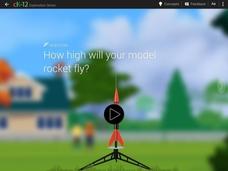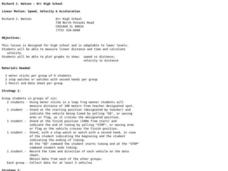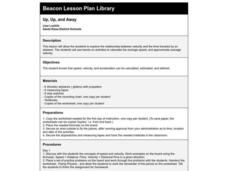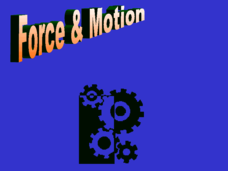CK-12 Foundation
Butterfly Stroke
Swimmers improve their times by understanding the physics of their sport. As a swimmer moves through the water, the efficiency of motion affects the resulting velocity. Through an interactive simulation, pupils change the level of motion...
CK-12 Foundation
Model Rocket
Acceleration, velocity, mass, and gravity all play a role in the motion of a rocket. Young scientists explore the connection among these components using an interactive tutorial. They adjust the mass and thrust force to experiment with...
Curated OER
Velocity
Students determine the average speed of a toy car as it travels six different distances set up by Students. Three trials are done for each distance. The only requirements is that the longest distance must be at least three times longer...
Curated OER
Functions
In this functions worksheet, students solve and complete 5 different sets of problems that include determining functions on intervals. First, they define a definite integral and the Fundamental Theorem of Calculus. Then, students draw a...
Curated OER
Linear Motion: Speed, Velocity & Acceleration
Learners explore the concept of linear motion. For this linear motion lesson, students calculate distance and time in order to calculate average speed and velocity in the provided problems.
Curated OER
Lesson #20 Rates of Change and Velocity
Students investigate speed. In this rate of change lesson, students complete a rate/time/distance table to determine the average m.p.h. of a given trip. They listen and follow along with the lecture and examples to determine the average...
Curated OER
Motion: Speed, Velocity, Acceleration and Networking
Students interpret a variety of motion graphs. In this physics lesson, students calculate the speed and acceleration of objects using numerical data from graphs. They apply what they have learned to solve real world problems.
Curated OER
Instantaneous Velocity
In this velocity worksheet, students determine the average and instantaneous velocity. They compute the derivative of given functions. This one-page worksheet contains seven multi-step problems.
Curated OER
Speed and Distance
In this speed worksheet, learners create time vs. distance graphs to answer questions about average speed, average velocity, and acceleration. This worksheet has 3 problems to solve.
PHET
Forces and Motion
The average American will move 12 times, which results in a lot of moving furniture! Class members consider the forces required to move objects with a creative simulation that opens with the forces required to push a filing cabinet....
Curated OER
Projectile Motion (or You Bet Your Grade)
Young scholars experiment with the velocity of a spring. In this velocity lesson, students conduct trials in order to determine the initial velocity of a spring. They stretch the spring different amounts and fire it both horizontally and...
Curated OER
WS 5.6 Graham's Law
In this gases worksheet, students use the concepts of Graham's Law of diffusion to determine the velocity of gases and molecules. They describe kinetic energy and how it relates to the mass and velocity of objects.
Curated OER
Up, Up, and Away
Learners study the concepts of speed and velocity and complete practice problems. In small groups, students fly airplanes and record time and distance traveled for each flight. They calculate the speed and velocity of their plane for...
Curated OER
Average Value of a Function
Students investigate the average value of a function given different interval values. In this calculus lesson, students explore word problems and apply their knowledge of average value to find the answer. They apply previous knowledge to...
Curated OER
Acceleration, Drag, Gravity, Motion, Forces, and Friction
Eighth graders build and run mousetrap cars in order to measure distance, time, and mass for their cars. They use these measurements to calculate average speed and kinetic energy, then create a slide show to visually explain how the car...
Curated OER
"Measurement in Motion"
Ninth graders examine the rate of motion and changes in motion using a ramp and a rolling object. They conduct the demonstration, determine the average speed, and describe how a moving object can have zero acceleration and deceleration.
Curated OER
Acceleration Lab
Young Einsteins experiment with the acceleration of Hot Wheels™ toy cars down inclined planes at various angles. This classic physics lab activity is thoroughly explained in both a teacher’s guide and a student lab sheet. Science...
Mr. E. Science
Motion
An informative presentation covers motion, metric system, conversions, graphing of coordinates and lines, speed, velocity, and acceleration problems, as well as mean calculations. This is the first lesson in a 26-part series.
Curated OER
Review of Kinematics
In this kinematics review worksheet, learners complete 50 multiple choice questions on average speed, velocity and acceleration.
Curated OER
Typical Numeric Questions for Physics I - Momentum
Simple momentum computations and more complex collision computations can be found on these two worksheets. All of them can be answered by choosing from five possibilities. The first worksheet contains nine problems to solve, while the...
Curated OER
Force and Motion
Each of the slides here gives a definition, equation, or calculation example for a component of force and motion. This large collection covers topics from momentum and Newton's laws to centripetal forces and simple machines. Animations...
Kenan Fellows
Engineering Skills Through Problem Based Learning
Navigate the ups and downs of learning about energy. Future engineers consider how potential and kinetic energy apply to roller coasters. They design a roller coaster of their own and then use computer design software to showcase their...
College Board
2003 AP® Calculus BC Free-Response Questions Form B
Be integral to the learners in the classroom. Pupils use integrals, differentiation, and limits to solve the free-response questions from an AP® Calculus BC exam. Items cover topics such as area under a curve, particle motion, average...
Curated OER
Flying With Mathematics!
Third graders fly miniature airplanes to discover characteristics related to velocity and average speed. After measuring the time and distance of their flights, 3rd graders calculate the average velocity of their planes.

























